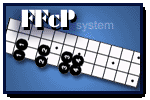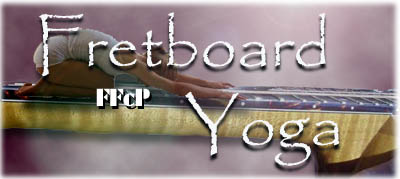|

In 2002, we began documenting our unique approach to developing mandolin fretboard familiarity. We felt the conventional approach to learning this, one in which the open strings become the anchor for understanding the instrument, each chromatic note regarded as somewhat of a continuum between, offered far to many limitations for a musician wanting to branch out into keys beyond G, D, and A, let alone the upper frets.
The perfect 5th tuning of the mandolin offers a truly unique opportunity; moving a scale or pattern up a string or two, up several frets, yet easily maintaining the relation with only four possibilities, a scale based on fingers 1, 2, 3, or 4. This is the whole basis of the FFcP approach.
That's it. You can't do this on a saxophone, trumpet, or piano. You can't even do this on a guitar, with that awkward 3rd between the G and B strings. Violins, Cellos, Mandolins, Violas, and Tenor Guitars can do this, but with one minor sacrifice, leaving the safety of open strings. The payoff is huge, however. Building the 3rd and 4th finger give you incredible flexibility and melodic dexterity once developed. Improvisations became tactile and subconscious. (You can read more about these features in the introduction of the first FFcP lesson.)
We've added FFcP exercises since that first inaugural one, but this is definitely where you'll want to begin if this is all foreign to you. Start there, spend a few months making them confident and intuitive before progressing to the harder ones.
The following is a summary and URL link to advanced exercises:
FFcP Index
- FFcP Introduction.
This is the beginning of the FFcP journey. It explains the general concept and includes the full PDF exercise. It is also repeated over at the Mandolin Cafe
- Moving up the Fingerboard
This is where the system starts to shine, moving the 4 FFcP patterns up the fingerboard and bridging new roads by connecting them in two-octave patterns. The PDF that goes with this is easily memorized if you have had a few months working up the first lesson.
- Advanced FFcP
Combining various sets of FFcP, the accompanying Super FFcP PDF file gives you a higher level application to effectively jumping into a second octave of the fingerings. This can help infuse melodic "nuggets" into your improvisation, and minimize the fear in leaving the lower frets.
- Chromatic Mastering, Working Chromatic Descending and Ascending Tonal Centers.
Believing the 3rd position of mandolin (3rd fret to 9th) is optimum area for mandolin tone, we develop a sense of "belonging" working the FFcP positions into a daily exercise in which each FFcP in moved incrementally up one fret. This is a personal favorite; one to be played at slow tempos so as to develop robust tone. (Tone, tone, TONE!) The PDF exercise is very easy to memorize if you're already comfortable with the basic FFcP patterns.
- Pentatonic FFcP.
A huge mistake a majority of mandolinists make is learning Pentatonic Scales and never leaving the fiddle tune keys. There is a rich tradition of complex applications of the pentatonic scale, but you will never have access to this until you can mix them up into different keys. Once you do, you have the secrets of improvisation used by the likes of McCoy Tyner, John Coltrane, and many others. This PDF is Pentatonics on steroids.
- Dorian/Minor FFcP.
Why Dorian/Minor? The traditional study of the three minor scale modes (natural, harmonic, and melodic) betrays contextual function in jazz. More often than not, you'll use some kind of Dorian Mode, which offers the "minor-ness" of the lowered 3rd, but maintains a harmonic neutrality in the 6th and 7th scale degrees. We've inserted a taste of harmonic function in the 'i VI ii7b5 V7' patterns to lend your ear some familiarity within a chord context. This PDF is yet another great workout for brain and fingers.
- Augmented 11th FFcP
We're so bold as to call this the 2nd most important scale pattern in jazz--at least our approach, anyway. This sequence of notes will carry you miles in creating amazing solos for Dominant Functioning chords, and it contains a verdant, melodic vocabulary based on five different scales, all the same notes! After you've master Major, Pentatonic and Minor, use this PDF to tear up the mandolin fretboard!

Visit the JazzMando Facebook Page

We're considering publishing an entire method book of FFcP patterns, licks, and exercises. Are you interested, and if so, what would you like to see in it? What are we missing? Weigh in on our study: Contact Form

Disclaimer: In the 'Information Age' of the 21st Century,
any fool with a computer, a modem, and an idea can
become a self-professed 'expert." This site does not
come equipped with 'discernment.'
|
|



